Sliding and Fretting Wear Behavior of Biomedical Ultrafine-Grained TiNbZrTaFe/Si Alloys in Simulated Physiological Solution
Abstract
1. Introduction
2. Experimental Methods
2.1. Fabrication and Characteristics of the Bulk TNZTF and TNZTS Alloys
2.2. Wear Tests
3. Results and Discussion
3.1. Phase and Microstructure Characterizations
3.2. Wear Characterization
3.2.1. XPS Analysis
3.2.2. Wear Volume
3.2.3. 3D Optical Micrographs of Wear Scars
3.2.4. Comparative Analysis of Wear Morphology and Wear Mechanism
4. Conclusions
Author Contributions
Funding
Institutional Review Board Statement
Informed Consent Statement
Data Availability Statement
Conflicts of Interest
References
- Jawed, S.F.; Liu, Y.J.; Wang, J.C.; Rabadia, C.D.; Wang, L.Q.; Li, Y.H.; Zhang, X.H.; Zhang, L.C. Tailoring deformation and superelastic behaviors of beta-type Ti-Nb-Mn-Sn alloys. J. Mech. Behav. Biomed. 2020, 110, 103867. [Google Scholar] [CrossRef] [PubMed]
- Jawed, S.F.; Rabadia, C.D.; Liu, Y.J.; Wang, L.Q.; Qin, P.; Li, Y.H.; Zhang, X.H.; Zhang, L.C. Strengthening mechanism and corrosion resistance of beta-type Ti-Nb-Zr-Mn alloys. Mat. Sci. Eng. C-Mater. 2020, 110, 110728. [Google Scholar] [CrossRef] [PubMed]
- Jawed, S.F.; Rabadia, C.D.; Liu, Y.J.; Wang, L.Q.; Li, Y.H.; Zhang, X.H.; Zhang, L.C. Mechanical characterization and deformation behavior of β-stabilized Ti-Nb-Sn-Cr alloys. J. Alloy Compd. 2019, 792, 684–693. [Google Scholar] [CrossRef]
- Song, C.H.; Liu, L.S.; Deng, Z.T.; Lei, H.Y.; Yuan, F.Z.; Yang, Y.Q.; Li, Y.Y.; Yu, J.K. Research progress on the design and performance of porous titanium alloy bone implants. J. Mater. Res. Technol. 2023, 23, 2626–2641. [Google Scholar] [CrossRef]
- Zhang, L.C.; Chen, L.Y. A review on biomedical titanium alloys: Recent progress and prospect. Adv. Eng. Mater. 2019, 21, 1801215. [Google Scholar] [CrossRef]
- Qin, P.; Chen, L.Y.; Zhao, C.H.; Liu, Y.J.; Cao, C.D.; Sun, H.; Zhang, L.C. Corrosion behavior and mechanism of selective laser melted Ti35Nb alloy produced using pre-alloyed and mixed powder in Hank’s solution. Corros. Sci. 2021, 189, 109609. [Google Scholar] [CrossRef]
- Li, Y.H.; Yang, C.; Zhao, H.D.; Qu, S.G.; Li, X.Q.; Li, Y.Y. New developments of Ti-based alloys for biomedical applications. Materials 2014, 7, 1709–1800. [Google Scholar] [CrossRef] [PubMed]
- Geetha, M.; Singh, A.K.; Asokamani, R.; Gogia, A.K. Ti based biomaterials, the ultimate choice for orthopaedic implants—A review. Prog. Mater. Sci. 2009, 54, 397–425. [Google Scholar] [CrossRef]
- Ma, H.Y.; Wang, J.C.; Qin, P.; Liu, Y.J.; Chen, L.Y.; Wang, L.Q.; Zhang, L.C. Advances in additively manufactured titanium alloys by powder bed fusion and directed energy deposition: Microstructure, defects, and mechanical behavior. J. Mater. Sci. Technol. 2024, 183, 32–62. [Google Scholar] [CrossRef]
- Hsu, H.C.; Wong, K.K.; Wu, S.C.; Chen, Y.X.; Ho, W.F. Metastable dual-phase Ti–Nb–Sn–Zr and Ti–Nb–Sn–Fe alloys with high strength-to-modulus ratio. Mater. Today Commun. 2022, 30, 103168. [Google Scholar] [CrossRef]
- Zhang, L.C.; Chen, L.Y.; Zhou, S.F.; Luo, Z. Powder bed fusion manufacturing of beta-type titanium alloys for biomedical implant applications: A review. J. Alloy Compd. 2023, 936, 168099. [Google Scholar] [CrossRef]
- Çomaklı, O. Improved structural, mechanical, corrosion and tribocorrosion properties of Ti45Nb alloys by TiN, TiAlN monolayers, and TiAlN/TiN multilayer ceramic films. Ceram. Int. 2021, 47, 4149–4156. [Google Scholar] [CrossRef]
- Odehnal, L.; Ranuša, M.; Vrbka, M.; Křupka, I.; Hartl, M. Tribological behaviour of Ti6Al4V alloy: An application in small joint implants. Tribol. Lett. 2023, 71, 125. [Google Scholar] [CrossRef]
- Ataee, A.; Li, Y.C.; Wen, C. A comparative study on the nanoindentation behavior, wear resistance and in vitro biocompatibility of SLM manufactured CP–Ti and EBM manufactured Ti64 gyroid scaffolds. Acta Biomater. 2019, 97, 587–596. [Google Scholar] [CrossRef]
- Simsek, I.; Ozyurek, D. Investigation of the wear and corrosion behaviors of Ti5Al2.5Fe and Ti6Al4V alloys produced by mechanical alloying method in simulated body fluid environment. Mat. Sci. Eng. C-Mater. 2019, 94, 357–363. [Google Scholar] [CrossRef]
- Ibrahim, M.Z.; Sarhan, A.A.D.; Yusuf, F.; Hamdi, M. Biomedical materials and techniques to improve the tribological, mechanical and biomedical properties of orthopedic implants—A review article. J. Alloy Compd. 2017, 714, 636–667. [Google Scholar] [CrossRef]
- Zhang, L.C.; Chen, L.Y.; Wang, L.Q. Surface modification of titanium and titanium alloys: Technologies, developments, and future interests. Adv. Eng. Mater. 2020, 22, 1901258. [Google Scholar] [CrossRef]
- Liu, R.; Yuan, S.; Lin, N.M.; Zeng, Q.F.; Wang, Z.H.; Wu, Y.C. Application of ultrasonic nanocrystal surface modification (UNSM) technique for surface strengthening of titanium and titanium alloys: A mini review. J. Mater. Res. Technol. 2021, 11, 351–377. [Google Scholar] [CrossRef]
- Kim, K.; Lee, B.A.; Piao, X.H.; Chung, H.J.; Kim, Y.J. Surface characteristics and bioactivity of an anodised titanium surface. J. Periodontal Implant Sci. 2013, 43, 198–205. [Google Scholar] [CrossRef] [PubMed]
- Kumar, S.; Mandal, A.; Das, A.K. The effect of process parameters and characterization for the laser cladding of cBN based composite clad over the Ti6Al4V alloy. Mater Chem. Phys. 2022, 288, 126410. [Google Scholar] [CrossRef]
- Nikolova, M.; Ormanova, M.; Nikolova, V.; Apostolova, M.D. Electrochemical, tribological and biocompatible performance of electron beam modified and coated Ti6Al4V alloy. Int. J. Mol. Sci. 2021, 22, 6369. [Google Scholar] [CrossRef] [PubMed]
- Sun, F.; Liu, X.L.; Luo, S.Q.; Xiang, D.D.; Ba, D.C.; Lin, Z.; Song, G.Q. Duplex treatment of arc plasma nitriding and PVD TiN coating applied to dental implant screws. Surf. Coat Technol. 2022, 439, 128449. [Google Scholar] [CrossRef]
- Yumusak, G.; Leyland, A.; Matthews, A. A microabrasion wear study of nitrided α-Ti and β-Ti Nb PVD metallic thin films, pre-deposited onto titanium alloy substrates. Surf. Coat Technol. 2022, 442, 128423. [Google Scholar] [CrossRef]
- Kong, W.H.; Villapun, V.M.; Lu, Y.; Carter, L.N.; Kuang, M.; Cox, S.; Attallah, M.M. The influence of thermal oxidation on the microstructure, fatigue properties, tribological and in vitro behaviour of laser powder bed fusion manufactured Ti-34Nb-13Ta-5Zr-0.2O alloy. J. Alloy Compd. 2022, 929, 167264. [Google Scholar] [CrossRef]
- Henao, J.; Mazon, O.S.; Betancur, A.G.; Bedoya, J.H.; Arbelaez, D.E.; Salas, C.P.; Arteaga, C.C.; Castuera, J.C.; Gomez, L.M. Study of HVOF-sprayed hydroxyapatite/titania graded coatings under in-vitro conditions. J. Mater. Res. Technol. 2020, 9, 14002–14016. [Google Scholar] [CrossRef]
- Chu, J.H.; Tong, L.B.; Jiang, Y.; Li, X.W.; Jiang, Z.H.; Li, Y.H.; Zhang, C.W. In-situ reduction enhanced waterborne graphene-based biomimetic coating based on a glutaraldehyde covalent bonding fixation strategy. Prog. Org. Coat. 2023, 183, 107800. [Google Scholar] [CrossRef]
- Ching, H.A.; Choudhury, D.; Nine, M.J.; Abu Osman, N.A. Effects of surface coating on reducing friction and wear of orthopaedic implants. Sci. Technol. Adv. Mater. 2014, 15, 014402. [Google Scholar] [CrossRef] [PubMed]
- Semenova, I.P.; Modina, Y.M.; Stotskiy, A.G.; Polyakov, A.V.; Pesin, M.V. Fatigue properties of Ti alloys with an ultrafine grained structure: Challenges and achievements. Metals 2022, 12, 312. [Google Scholar] [CrossRef]
- Valiev, R.R.; Selivanov, K.S.; Smyslova, M.K.; Dyblenko, Y.M.; Savina, Y.N.; Valiev, R.Z.; Semenova, I.P. Enhanced erosion resistance of an ultrafine-grained Ti alloy with a PVD coating. Metals 2022, 12, 818. [Google Scholar] [CrossRef]
- Bright, R.; Hayles, A.; Fernandes, D.; Visalakshan, R.M.; Ninan, N.; Palms, D.; Burzava, A.; Barker, D.; Brown, T.; Vasilev, K. In vitro bactericidal efficacy of nanostructured Ti6Al4V surfaces is bacterial load dependent. ACS Appl. Mater. Interfaces 2021, 13, 38007–38017. [Google Scholar] [CrossRef]
- Hayles, A.; Hasan, J.; Bright, R.; Palms, D.; Brown, T.; Barker, D.; Vasilev, K. Hydrothermally etched titanium: A review on a promising mechano-bactericidal surface for implant applications. Mater. Today Chem. 2021, 22, 100622. [Google Scholar] [CrossRef]
- Wood, J.; Hayles, A.; Bright, R.; Palms, D.; Vasilev, K.; Hasan, J. Nanomechanical tribological characterisation of nanostructured titanium alloy surfaces using AFM: A friction vs velocity study. Colloids Surf. B 2022, 217, 112600. [Google Scholar] [CrossRef] [PubMed]
- Yang, T.; Venkatesh, T.A.; Dao, M. Modeling fretting wear resistance and shakedown of metallic materials with graded nanostructured surfaces. Nanomaterials 2023, 13, 1584. [Google Scholar] [CrossRef]
- Lee, Y.S.; Niinomi, M.; Nakai, M.; Narita, K.; Cho, K. Predominant factor determining wear properties of β-type and (α+β)-type titanium alloys in metal-to-metal contact for biomedical applications. J. Mech. Behav. Biomed. 2015, 41, 208–220. [Google Scholar] [CrossRef]
- Hussein, M.; Mohammed, A.S.; Al-Aqeeli, N. Wear characteristics of metallic biomaterials: A review. Materials 2015, 8, 2749–2768. [Google Scholar] [CrossRef]
- Hu, S.W.; Li, T.J.; Su, Z.Q.; Liu, D.X. Research on suitable strength, elastic modulus and abrasion resistance of Ti–Zr–Nb medium entropy alloys (MEAs) for implant adaptation. Intermetallics 2022, 140, 107401. [Google Scholar] [CrossRef]
- Cvijovic´-Alagic´, I.; Cvijovic´, Z.; Mitrovic´, S.; Panic´, V.; Rakin, M. Wear and corrosion behaviour of Ti–13Nb–13Zr and Ti–6Al–4V alloys in simulated physiological solution. Corros. Sci. 2011, 53, 796–808. [Google Scholar] [CrossRef]
- Wang, W.J.; Yang, K.H.; Wang, Q.T.; Dai, P.Q.; Fang, H.; Wu, F.J.; Guo, Q.H.; Liaw, P.K.; Hua, N.B. Novel Ti-Zr-Hf-Nb-Fe refractory high-entropy alloys for potential biomedical applications. J. Alloy Compd. 2022, 906, 164383. [Google Scholar] [CrossRef]
- Alberta, L.A.; Vishnu, J.; Douest, Y.; Perrin, K.; Trunfio-Sfarghiu, A.M.; Courtois, N.; Gebert, A.; Ter-Ovanessian, B.; Calin, M. Tribocorrosion behavior of β-type Ti-Nb-Ga alloys in a physiological solution. Tribol. Int. 2023, 181, 108325. [Google Scholar] [CrossRef]
- Silva, D.; Arcos, C.; Montero, C.; Guerra, C.; Martínez, C.; Li, X.J.; Ringuede, A.; Cassir, M.; Ogle, K.; Guzman, D.; et al. A tribological and ion released research of Ti-materials for medical devices. Materials 2022, 15, 131. [Google Scholar] [CrossRef]
- Hezil, N.; Aissani, L.; Fellah, M.; Samad, M.A.; Obrosov, A.; Timofei, C.; Marchenko, E. Structural, and tribological properties of nanostructured α + β type titanium alloys for total hip. J. Mater. Res. Technol. 2022, 19, 3568–3578. [Google Scholar] [CrossRef]
- El-Sayed Seleman, M.M.; Ataya, S.; Aly, H.A.; Haldar, B.; Alsaleh, N.A.; Ahmed, M.M.Z.; Bakkar, A.; Ibrahim, K.M. Effect of the Si content on the dry and wet sliding wear behavior of the developed Ti-15Mo-(0-2) Si alloys for biomedical applications. Metals 2023, 13, 1861. [Google Scholar] [CrossRef]
- Xu, W.; Lu, X.; Tian, J.J.; Huang, C.; Chen, M.; Yan, Y.; Wang, L.N.; Qu, X.H.; Wen, C. Microstructure, wear resistance, and corrosion performance of Ti35Zr28Nb alloy fabricated by powder metallurgy for orthopedic applications. J. Mater. Sci. Technol. 2020, 41, 191–198. [Google Scholar] [CrossRef]
- Hua, N.B.; Hong, X.S.; Lin, L.Y.; Liao, Z.L.; Zhang, L.; Ye, X.Y.; Wang, Q.T. Mechanical, corrosion, and wear performances of a biocompatible Ti-based glassy alloy. J. Non-Cryst. Solids 2020, 543, 120116. [Google Scholar] [CrossRef]
- Guerra, C.; Walczak, M.; Sancy, M.; Martínez, C.; Aguilar, C.; Kalbarczyk, M. Tribological performance of porous Ti–Nb–Ta–Fe–Mn alloy in dry condition. Materials 2020, 13, 3284. [Google Scholar] [CrossRef] [PubMed]
- Diomidis, N.; Mischler, S.; More, N.S.; Roy, M. Tribo-electrochemical characterization of metallic biomaterials for total joint replacement. Acta Biomater. 2012, 8, 852–859. [Google Scholar] [CrossRef] [PubMed]
- Mace, A.; Gilbert, J.L. Micro-asperity tribocorrosion of CoCrMo, Ti6Al4V, and 316 stainless steel in air and physiological solution: Small scale reciprocal sliding of a single diamond tip. Wear 2022, 498, 204332. [Google Scholar] [CrossRef]
- Figueiredo-Pina, C.G.; Guedes, M.; Sequeira, J.; Pinto, D.; Bernardo, N.; Carneiro, C. On the influence of streptococcus salivarius on the wear response of dental implants: An in vitro study. J. Biomed. Mater. Res. Part B Appl. Biomater. 2019, 107, 1393–1399. [Google Scholar] [CrossRef] [PubMed]
- Kitagawa, T.; Tanimoto, Y.; Iida, T.; Murakami, H. Effects of material and coefficient of friction on taper joint dental implants. J. Prosthodont. Res. 2020, 64, 359–367. [Google Scholar] [CrossRef] [PubMed]
- Alemanno, F.; Peretti, V.; Tortora, A.; Spriano, S. Tribological behaviour of Ti or Ti Alloy vs. Zirconia in presence of artificial saliva. Coatings 2020, 10, 851. [Google Scholar] [CrossRef]
- Wang, K.; Tong, X.; Lin, J.X.; Wei, A.P.; Li, Y.C.; Dargusch, M.; Wen, C.E. Binary Zn–Ti alloys for orthopedic applications: Corrosion and degradation behaviors, friction and wear performance, and cytotoxicity. J. Mater. Sci. Technol. 2021, 74, 216–229. [Google Scholar] [CrossRef]
- Pan, Y.; Li, W.B.; Lu, X.; Hayat, M.D.; Yin, L.; Song, W.W.; Qu, X.H.; Cao, P. Microstructure and tribological properties of titanium matrix composites reinforced with in situ synthesized TiC particles. Mater. Charact. 2020, 170, 110633. [Google Scholar] [CrossRef]
- Grabarczyk, J.; Gaj, J.; Pazik, B.; Kaczorowski, W.; Januszewicz, B. Tribocorrosion behavior of Ti6Al4V alloy after thermo-chemical treatment and DLC deposition for biomedical applications. Tribol. Int. 2021, 153, 106560. [Google Scholar] [CrossRef]
- Manicone, P.F.; Rossi Iommetti, P.; Raffaelli, L. An overview of zirconia ceramics: Basic properties and clinical applications. J. Dent. 2007, 35, 819–826. [Google Scholar] [CrossRef]
- Stemp, M.; Mischler, S.; Landolt, D. The effect of contact configuration on the tribocorrosion of stainless steel in reciprocating sliding under potentiostatic control. Corros. Sci. 2003, 45, 625–640. [Google Scholar] [CrossRef]
- Li, Y.H.; Yang, C.; Kang, L.M.; Zhao, H.D.; Qu, S.G.; Li, X.Q.; Zhang, W.W.; Li, Y.Y. Non-isothermal and isothermal crystallization kinetics and their effect on microstructure of sintered and crystallized TiNbZrTaSi bulk alloys. J. Non-Cryst. Solids 2016, 432, 440–452. [Google Scholar] [CrossRef]
- Li, Y.H.; Yang, C.; Wang, F.; Zhao, H.D.; Qu, S.G.; Li, X.Q.; Zhang, W.W.; Li, Y.Y. Biomedical TiNbZrTaSi alloys designed by d-electron alloy design theory. Mater. Des. 2015, 85, 7–13. [Google Scholar] [CrossRef]
- Lin, B.Z.; Yang, K.H.; Bao, X.G.; Liu, J.L.; Guo, Q.H.; Zhang, L.; Wang, Q.T.; Hua, N.B. Enhanced wear, corrosion, and corrosive-wear resistance of the biocompatible Ti-based bulk metallic glass by oxidation treatment. J. Non-Cryst. Solids 2022, 576, 121231. [Google Scholar] [CrossRef]
- Kheradmandfard, M.; Penkov, O.V.; Kashani-Bozorg, S.F.; Lee, J.S.; Kim, C.-L.; Khadem, M.; Cho, S.-W.; Hanzaki, A.Z.; Kim, D.-E. Exceptional improvement in the wear resistance of biomedical β-type titanium alloy with the use of a biocompatible multilayer Si/DLC nanocomposite coating. Ceram. Int. 2022, 48, 17376–17384. [Google Scholar] [CrossRef]
- Huang, X.; Liu, H.; Wang, Z.N.; Qiao, L.J.; Su, Y.J.; Yan, Y. Effect of surface oxidation on wear and tribocorrosion behavior of forged and selective laser melting-based TC4 alloys. Tribol. Int. 2022, 174, 107780. [Google Scholar] [CrossRef]
- Hatakeyama, M.; Masahashi, N.; Michiyama, Y.; Inoue, H.; Hanada, S. Wear resistance of surface-modified TiNbSn alloy. J. Mater. Sci. 2021, 56, 14333–14347. [Google Scholar] [CrossRef]
- Cui, Y.W.; Chen, L.Y.; Chu, Y.H.; Zhang, L.A.; Li, R.F.; Lu, S.; Wang, L.Q.; Zhang, L.C. Metastable pitting corrosion behavior and characteristics of passive film of laser powder bed fusion produced Ti–6Al–4V in NaCl solutions with different concentrations. Corros. Sci. 2023, 215, 111017. [Google Scholar] [CrossRef]
- Gabor, R.; Cvrcek, L.; Masek, K.; Hlinka, J.; Motyka, O.; Walter, J.; Martynková, G.S.; Mikesková, G.; Seidlerová, J. Tribological and corrosion properties of β-TiNb alloy modified by plasma electrolytic oxidation: Evaluation of the synergistic effect of composition and processing time through statistical evaluation. Int. J. Refract. Hard Meter. 2024, 118, 106502. [Google Scholar] [CrossRef]
- Zou, L.M.; Zhou, L.J.; Yang, C.; Qu, S.Q.; Li, Y.Y. Unusual dry sliding tribological behavior of biomedical ultrafine-grained TiNbZrTaFe composites fabricated by powder metallurgy. J. Mater. Res. 2014, 29, 902–909. [Google Scholar] [CrossRef]
- Attar, H.; Prashanth, K.G.; Chaubey, A.K.; Calin, M.; Zhang, L.C.; Scudino, S.; Eckert, J. Comparison of wear properties of commercially pure titanium prepared by selective laser melting and casting processes. Mater. Lett. 2015, 142, 38–41. [Google Scholar] [CrossRef]
- Orozco-Hernández, G.; Durán, P.G.; Aperador, W. Tribocorrosion evaluation of Nb2O5, TiO2, and Nb2O5 + TiO2 coatings for medical applications. Lubricants 2021, 9, 49. [Google Scholar] [CrossRef]
- Rajendhran, N.; De Baets, P.; Huang, S.G.; Vleugels, J.; Sukumaran, J. Single-point scratch testing for understanding particle engagement in abrasion of multiphase materials. Wear 2021, 476, 203689. [Google Scholar] [CrossRef]
- Zhang, P.; Cai, Z.; Yang, W.; Chen, J.; Luo, S.; Zeng, L. Comparative study on the generation and characteristics of debris induced by fretting and sliding. Materials 2022, 15, 4132. [Google Scholar] [CrossRef] [PubMed]
- Li, X.W.; Liang, J.S.; Shi, T.; Yang, D.N.; Chen, X.C.; Zhang, C.W.; Liu, Z.H.; Liu, D.Z.; Zhang, Q.X. Tribological behaviors of vacuum hot-pressed ceramic composites with enhanced cyclic oxidation and corrosion resistance. Ceram. Int. 2020, 46, 12911–12920. [Google Scholar] [CrossRef]
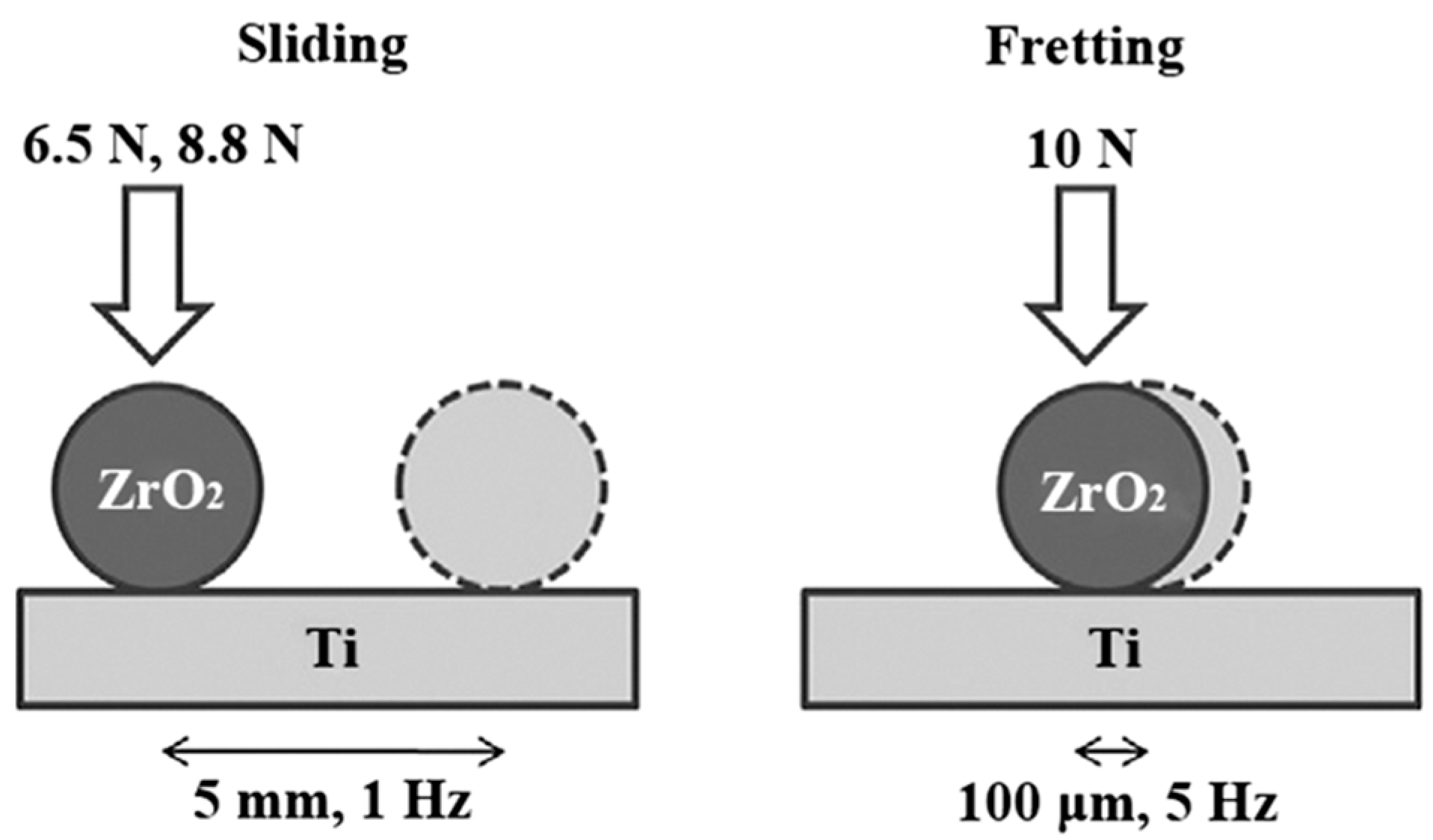
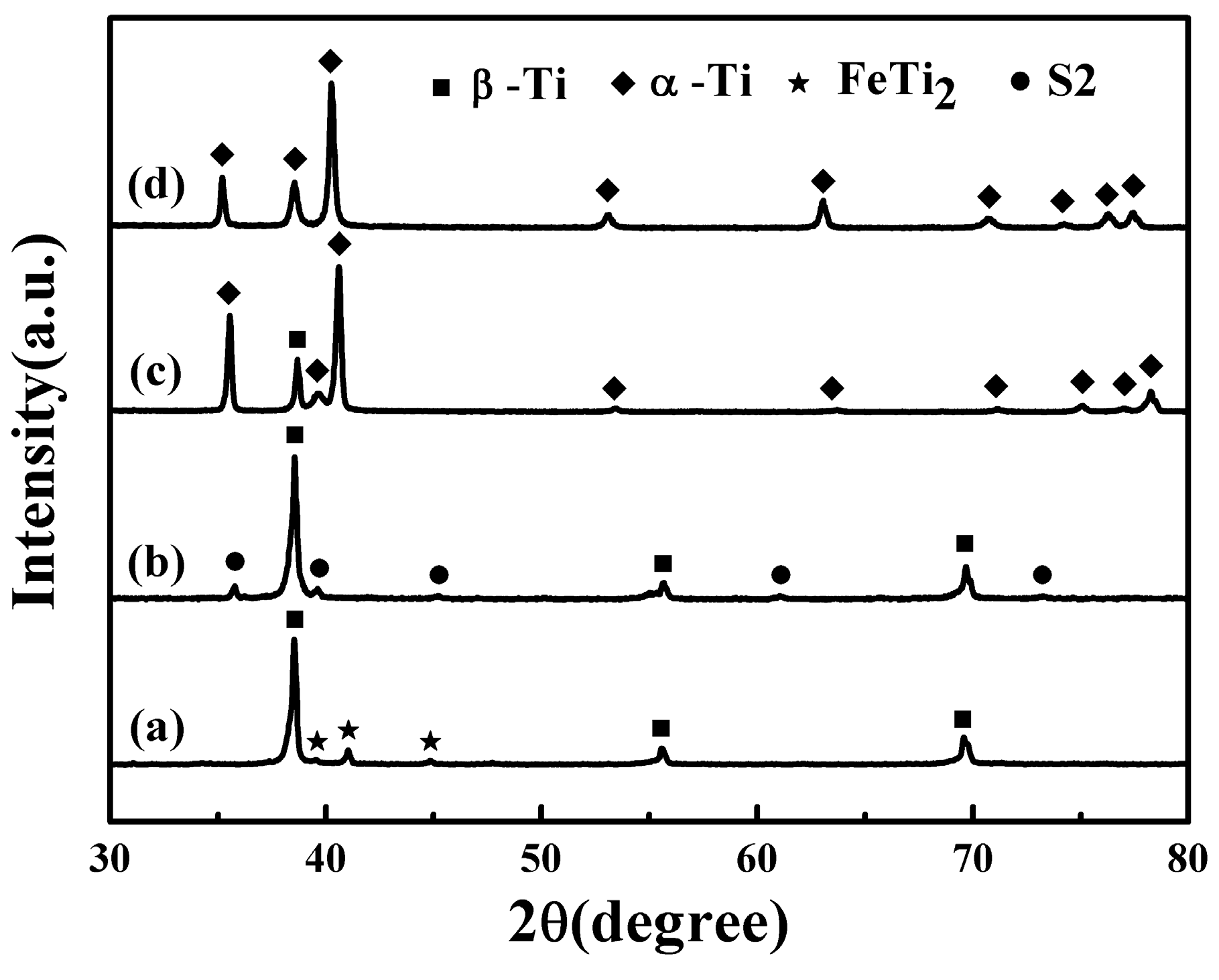
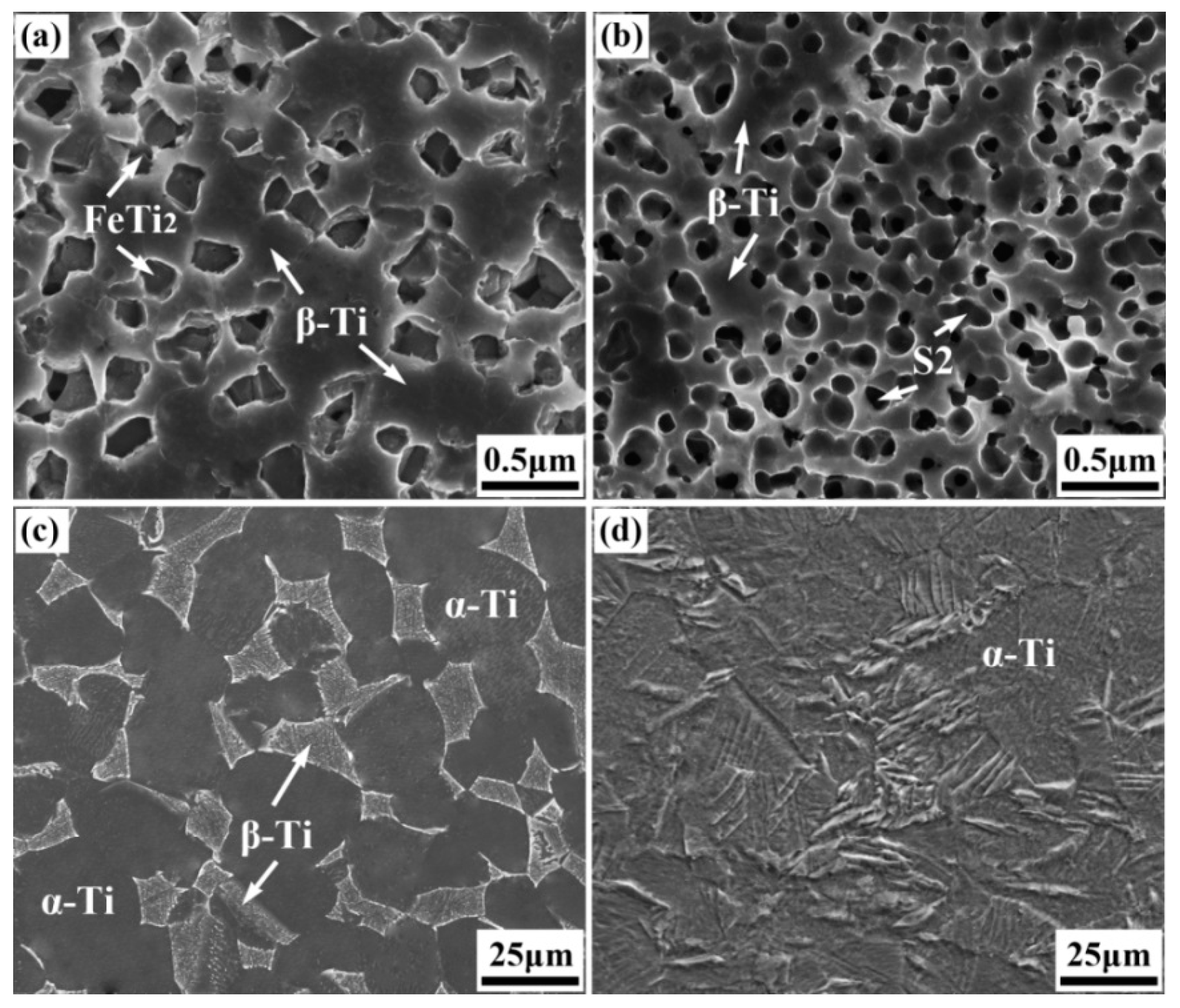
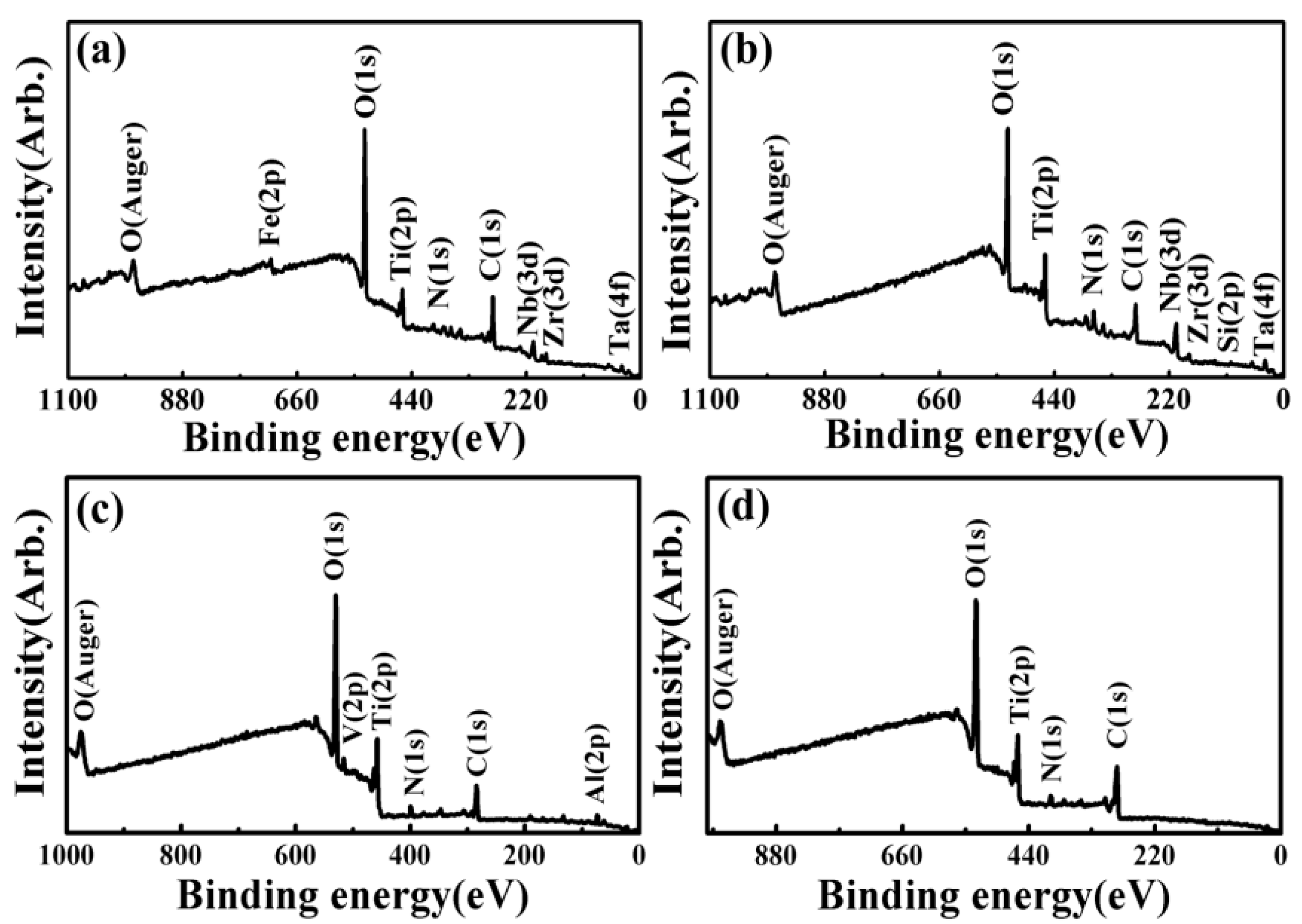
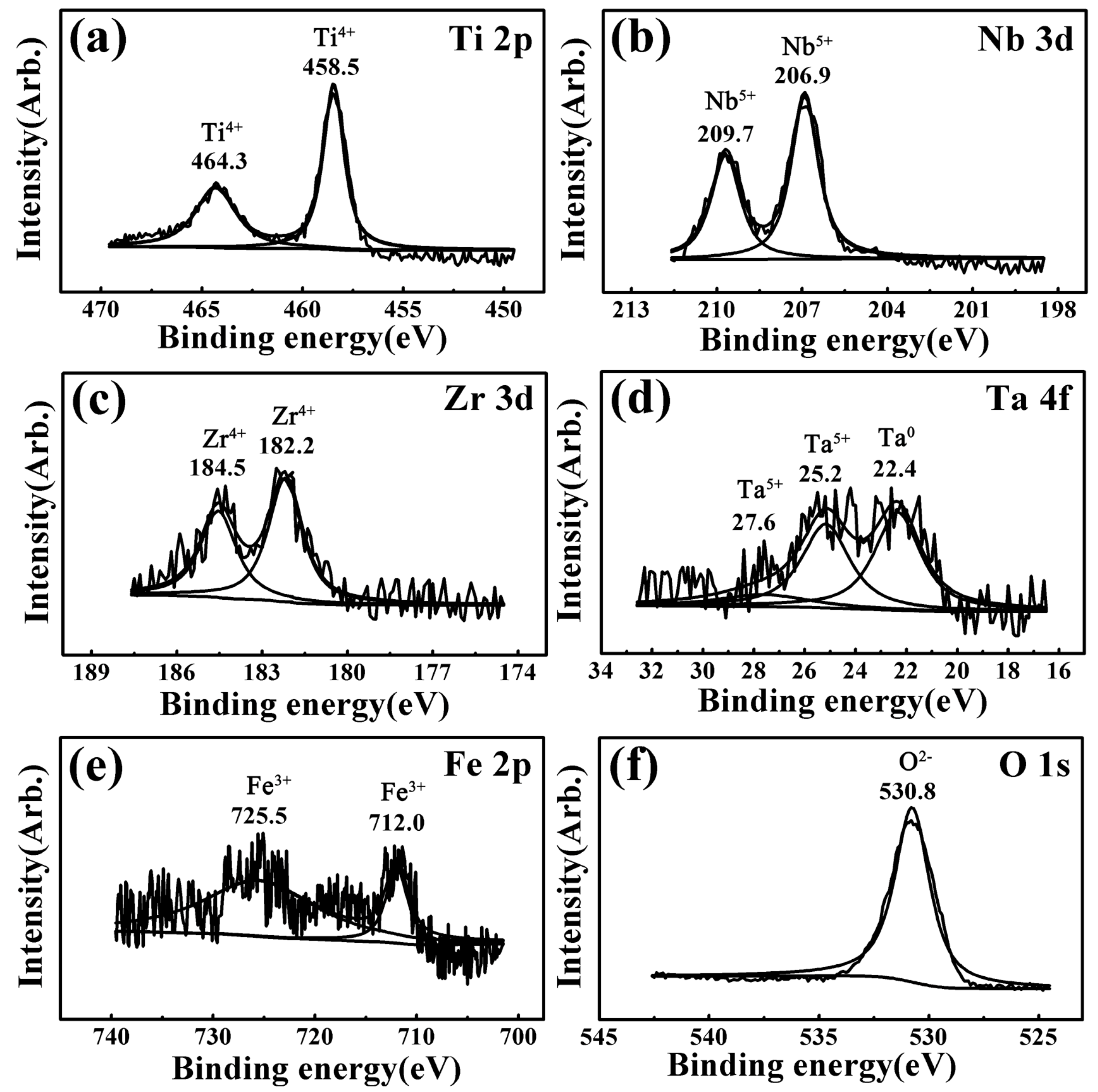
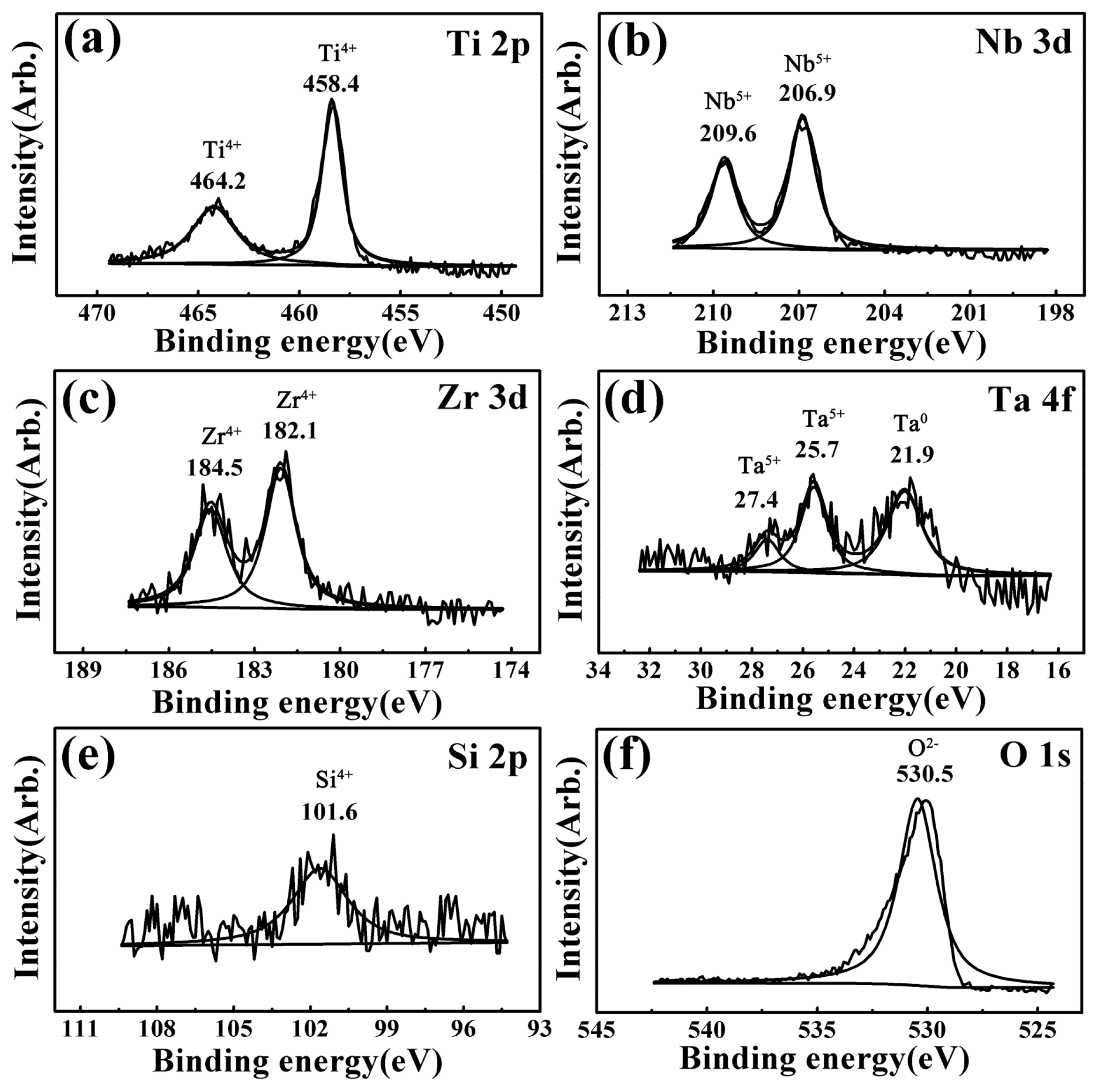
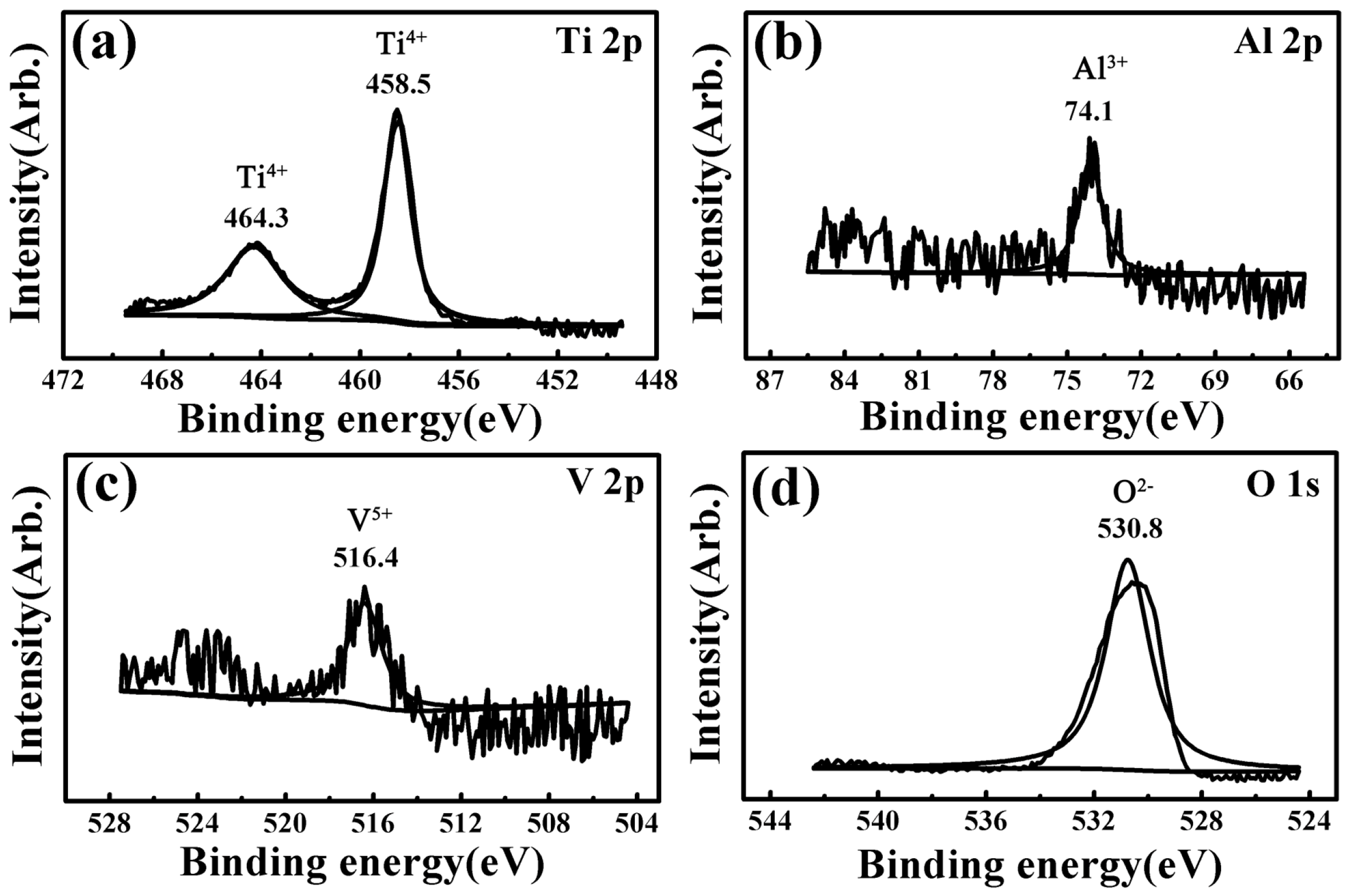
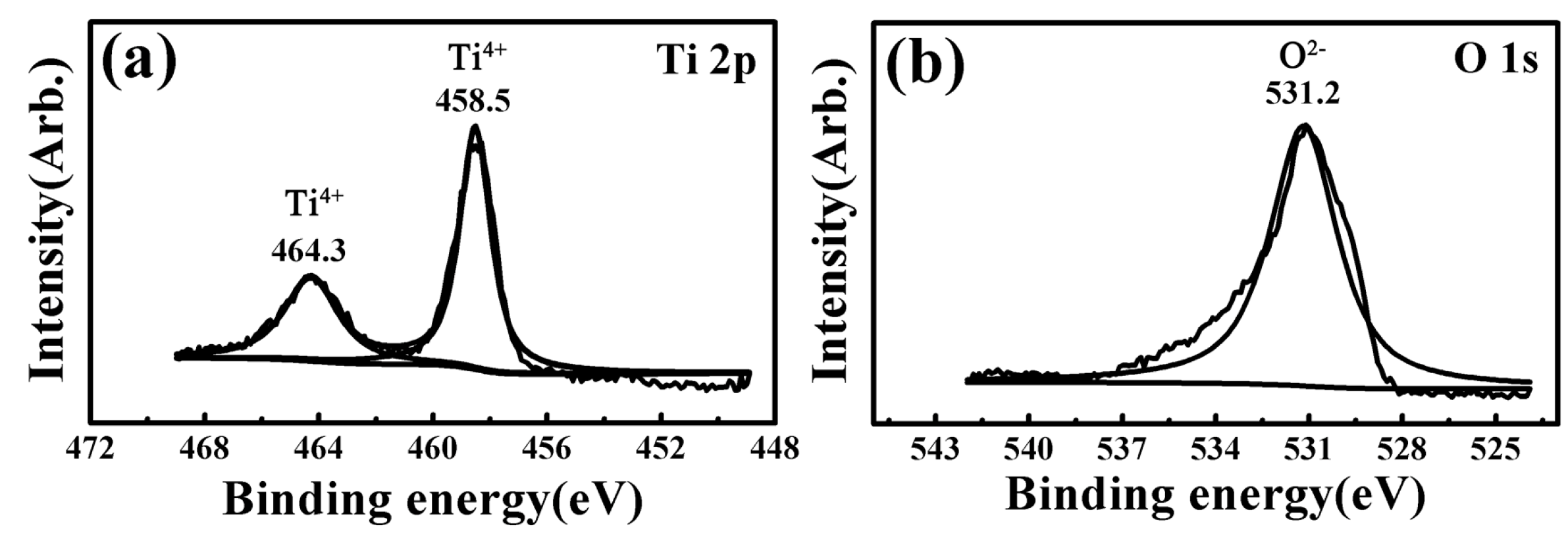
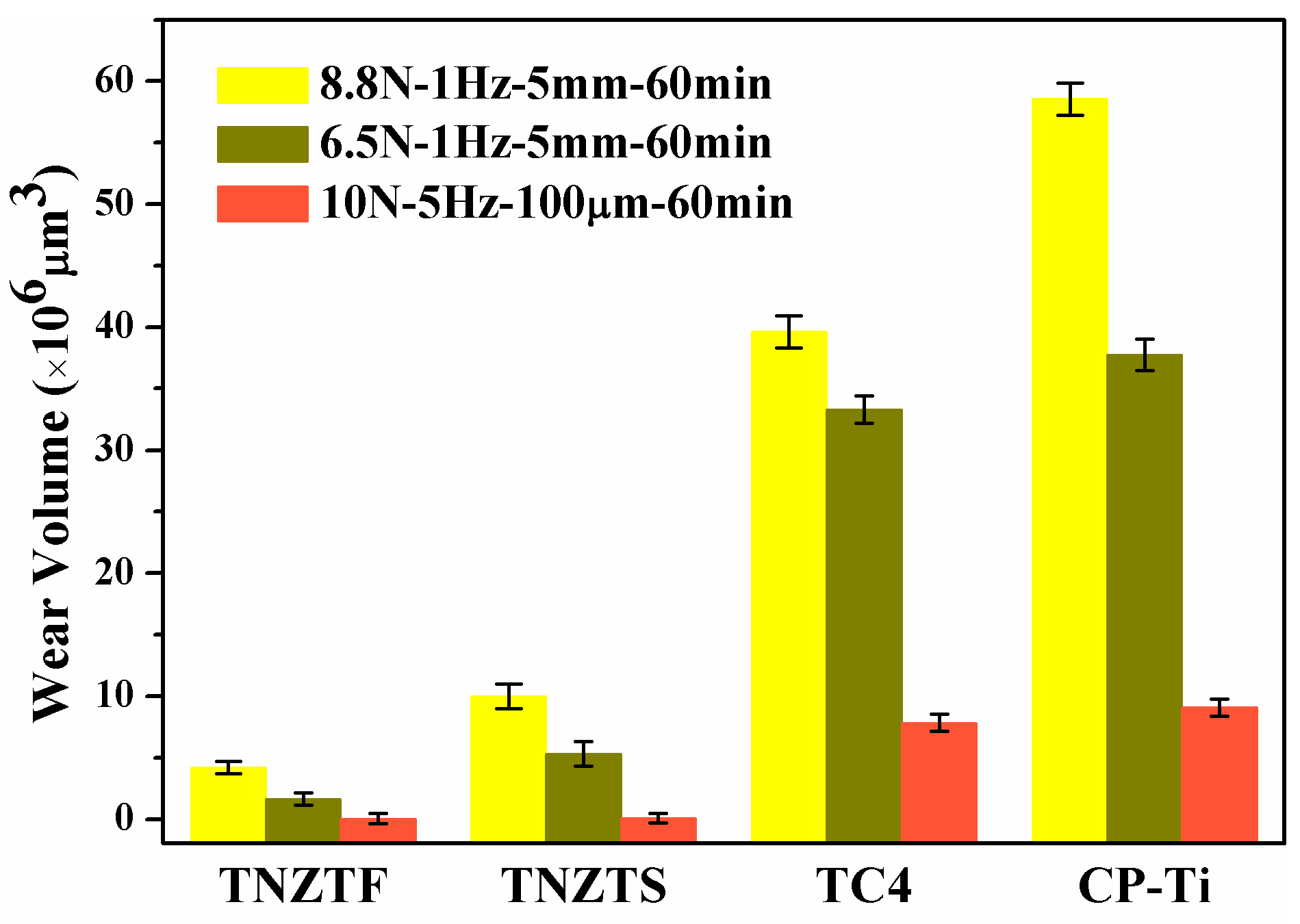
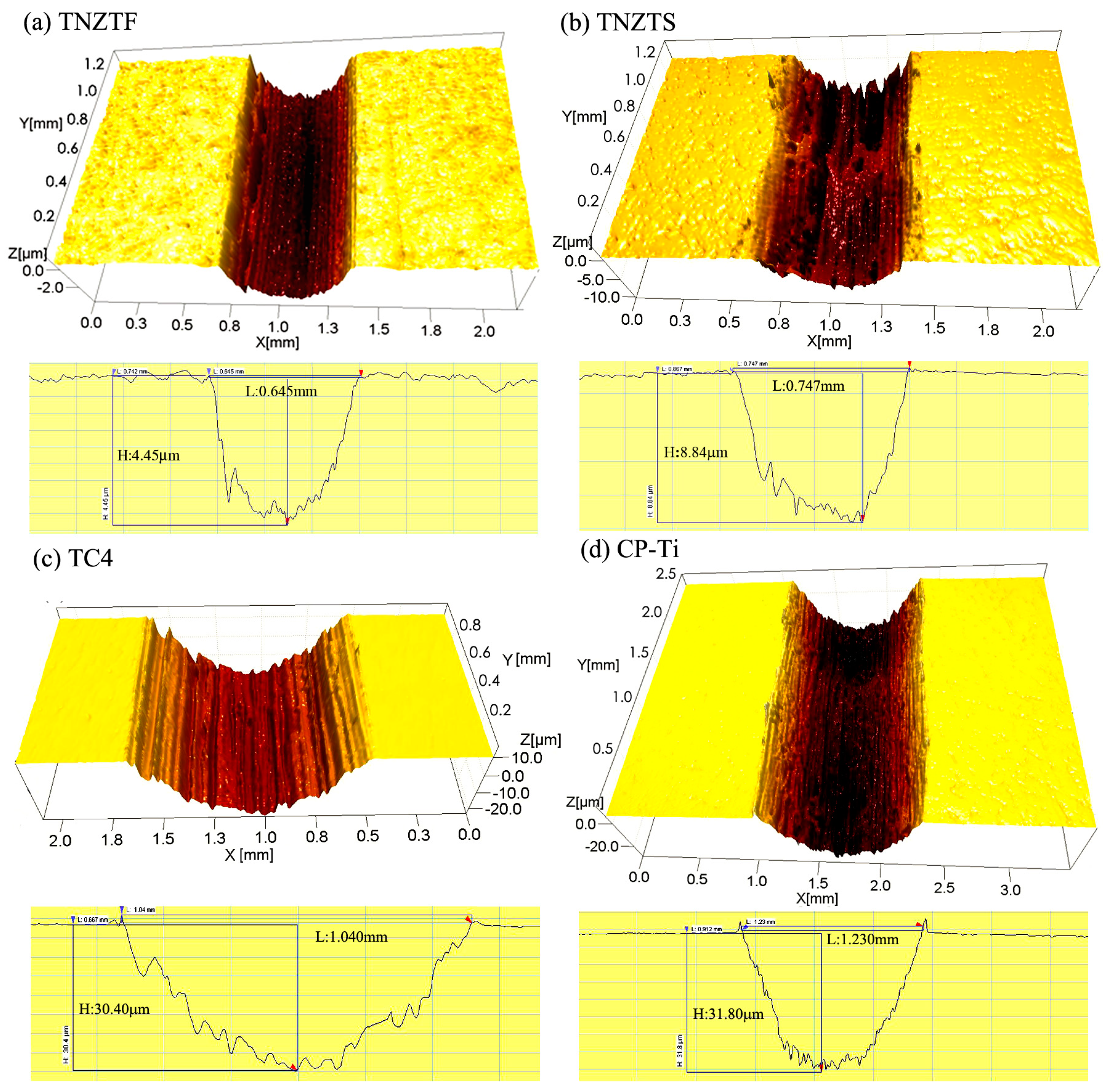
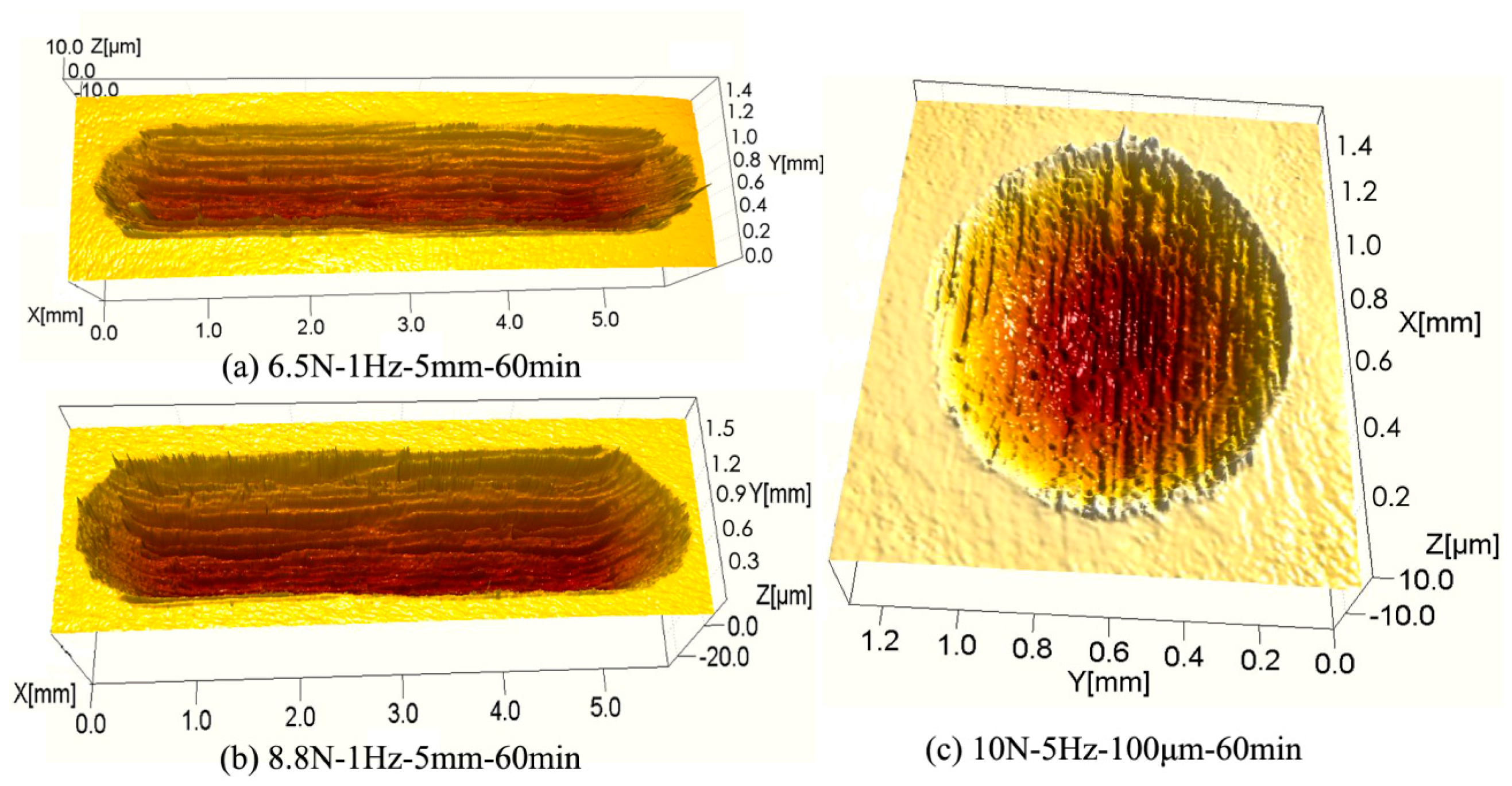
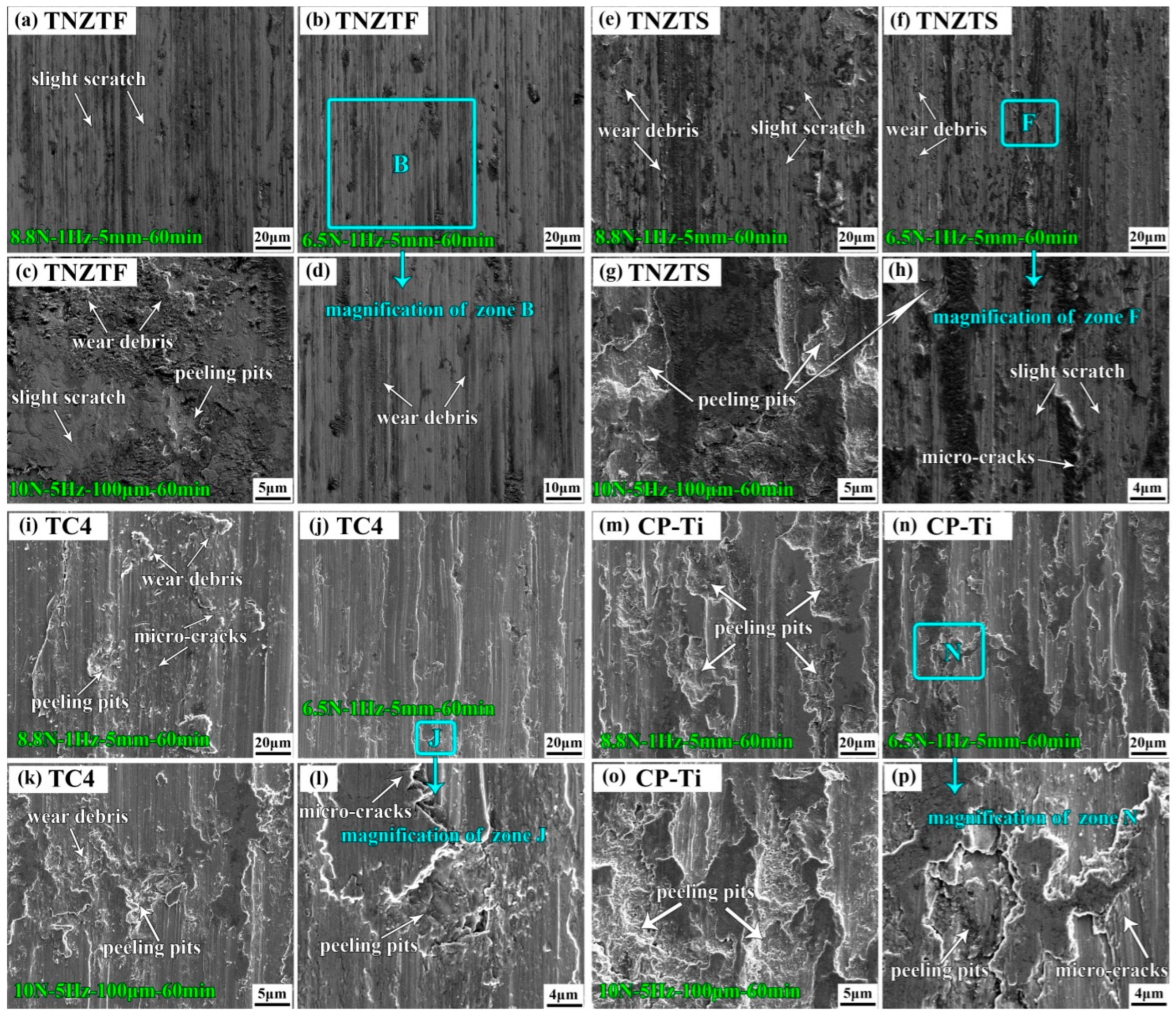
| Samples | Phase Constituents | σ0.2 (MPa) | σmax (MPa) | εf (%) | Hardness (HV) |
|---|---|---|---|---|---|
| TNZTF | β-Ti + FeTi2 | 2247 ± 5 | 2872 ± 5 | 23 ± 1 | 483 ± 4 |
| TNZTS | β-Ti + S2 | 1347 ± 5 | 3267 ± 10 | 58 ± 1 | 378 ± 3 |
| TC4 | β-Ti + α-Ti | 1005 ± 3 | 2350 ± 4 | 43 ± 1 | 294 ± 4 |
| CP-Ti | α-Ti | 402 ± 2 | 1151 ± 3 | 73 ± 2 | 180 ± 3 |
| Components (Inorganic Salts) | Molecular Weight | Concentration (mg/L) |
|---|---|---|
| CaCl2 | 111.0 | 140 |
| MgCl2·6H2O | 203.0 | 100 |
| MgSO4·7H2O | 246.0 | 100 |
| KCl | 75.0 | 400 |
| KH2PO4 | 136.0 | 60 |
| NaHCO3 | 84.0 | 350 |
| NaCl | 58.0 | 8000 |
| Na2HPO4 | 142.0 | 48 |
| Glucose | 180.0 | 1000 |
| Samples | Ti 2p | Nb 3d | Zr 3d | Ta 4f | Fe 2p | Si 2p | Al 2p | V 2p | O 1s |
|---|---|---|---|---|---|---|---|---|---|
| TNZTF | 458.5 | 206.9 | 182.2 | 25.2 | 712.0 | - | - | - | 530.8 |
| 464.3 | 209.7 | 184.5 | 27.6 | 725.5 | - | ||||
| TNZTS | 458.4 | 206.9 | 182.1 | 25.7 | - | 101.6 | - | - | 530.5 |
| 464.2 | 209.6 | 184.5 | 27.4 | - | - | ||||
| TC4 | 458.5 | - | - | - | - | - | 74.1 | 516.4 | 530.8 |
| 464.3 | - | - | - | ||||||
| CP-Ti | 458.5 | - | - | - | - | - | - | - | 531.2 |
| 464.3 | - |
Disclaimer/Publisher’s Note: The statements, opinions and data contained in all publications are solely those of the individual author(s) and contributor(s) and not of MDPI and/or the editor(s). MDPI and/or the editor(s) disclaim responsibility for any injury to people or property resulting from any ideas, methods, instructions or products referred to in the content. |
© 2024 by the authors. Licensee MDPI, Basel, Switzerland. This article is an open access article distributed under the terms and conditions of the Creative Commons Attribution (CC BY) license (https://creativecommons.org/licenses/by/4.0/).
Share and Cite
Li, Y.; Zhang, Q.; He, Y.; Zhao, R.; Chu, J.; Niu, L.; Qu, J. Sliding and Fretting Wear Behavior of Biomedical Ultrafine-Grained TiNbZrTaFe/Si Alloys in Simulated Physiological Solution. Materials 2024, 17, 787. https://doi.org/10.3390/ma17040787
Li Y, Zhang Q, He Y, Zhao R, Chu J, Niu L, Qu J. Sliding and Fretting Wear Behavior of Biomedical Ultrafine-Grained TiNbZrTaFe/Si Alloys in Simulated Physiological Solution. Materials. 2024; 17(4):787. https://doi.org/10.3390/ma17040787
Chicago/Turabian StyleLi, Yuhua, Qian Zhang, Yuxin He, Rong Zhao, Jinghui Chu, Libin Niu, and Juxin Qu. 2024. "Sliding and Fretting Wear Behavior of Biomedical Ultrafine-Grained TiNbZrTaFe/Si Alloys in Simulated Physiological Solution" Materials 17, no. 4: 787. https://doi.org/10.3390/ma17040787
APA StyleLi, Y., Zhang, Q., He, Y., Zhao, R., Chu, J., Niu, L., & Qu, J. (2024). Sliding and Fretting Wear Behavior of Biomedical Ultrafine-Grained TiNbZrTaFe/Si Alloys in Simulated Physiological Solution. Materials, 17(4), 787. https://doi.org/10.3390/ma17040787





